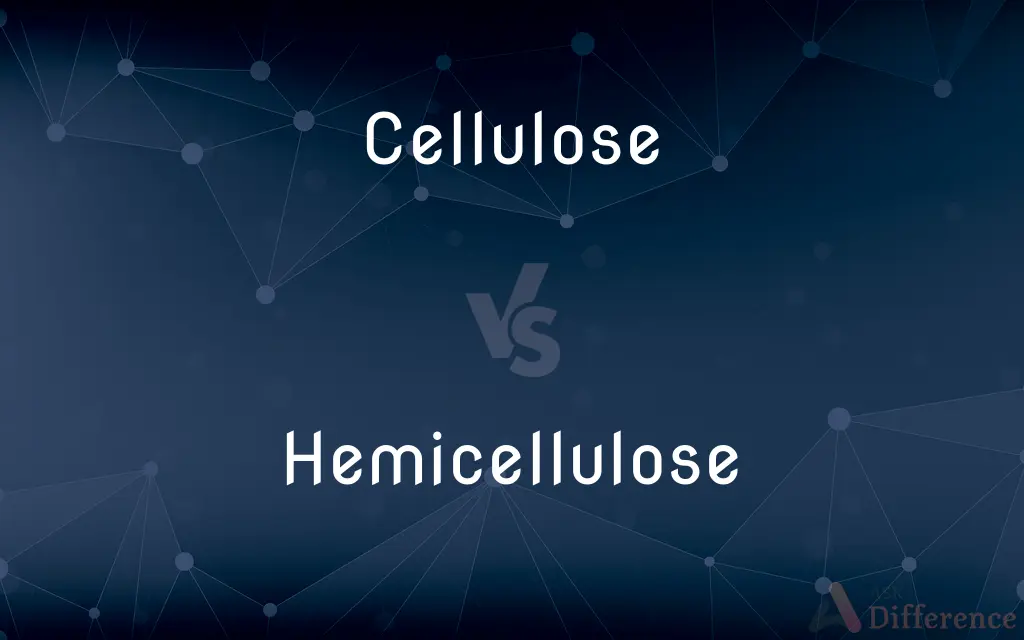Cellulose vs. Hemicellulose — What's the Difference?
Edited by Tayyaba Rehman — By Urooj Arif — Updated on March 14, 2024
Cellulose is a complex carbohydrate forming plant cell walls' structural component, while hemicellulose acts as a matrix filler between cellulose fibers.

Difference Between Cellulose and Hemicellulose
Table of Contents
ADVERTISEMENT
Key Differences
Cellulose is a polysaccharide composed of glucose units linked by β-1,4-glycosidic bonds, forming long, unbranched chains that aggregate into strong microfibrils. Hemicellulose, on the other hand, is a heterogeneous group of polysaccharides that include xylose, mannose, galactose, rhamnose, and arabinose, in addition to glucose. Unlike cellulose, hemicellulose consists of shorter, branched chains and is more easily hydrolyzed by acids or bases due to its amorphous structure.
This structure is crucial for providing tensile strength to plant cell walls, making cellulose the most abundant organic compound on Earth. It is resistant to hydrolysis and requires specific enzymes, like cellulase, for breakdown, which is why few organisms can digest cellulose efficiently. Hemicellulose serves as a filler material within the cell wall, surrounding the cellulose microfibrils and interacting with lignin, contributing to the overall architecture and flexibility of the wall.
While cellulose provides structural integrity to plant cell walls, enabling plants to stand upright and grow tall, hemicellulose plays a more supportive role, helping to bind cellulose fibers together and interfacing with other cell wall components. This complementary relationship is essential for the mechanical properties of plant cell walls, affecting their strength, rigidity, and resistance to physical and biological attacks. Hemicellulose is more soluble in water and easier to extract from biomass than cellulose, which is tightly packed and crystalline. This solubility plays a role in the industrial processing of plant materials, such as in the production of biofuels, where hemicellulose can be more readily converted into fermentable sugars compared to cellulose.
The distinct chemical structures of cellulose and hemicellulose influence their respective roles in nature and their applications in various industries. While cellulose is utilized for its strength and durability, hemicellulose's utility lies in its flexibility and ease of breakdown, which is exploited in the paper and pulp industry, as well as in biofuel production.
Comparison Chart
Composition
Long, unbranched chains of glucose
Shorter, branched chains of various sugars
ADVERTISEMENT
Structure
Crystalline, highly ordered
Amorphous, less ordered
Solubility
Insoluble in water, resistant to hydrolysis
Soluble in water, easily hydrolyzed
Function in plants
Provides tensile strength to cell walls
Acts as a matrix filler, contributing to wall flexibility
Industrial applications
Paper production, textile, biofuels (harder)
Biofuels (easier), food industry, paper and pulp processing
Compare with Definitions
Cellulose
High tensile strength, insoluble in water.
The tensile strength of cellulose makes it ideal for strong fibers.
Hemicellulose
Works with cellulose and lignin to provide plant cell wall structure.
Hemicellulose binds with cellulose fibers, adding flexibility.
Cellulose
Primary building block of plant cell walls, providing rigidity.
Cellulose fibers give plants their structural integrity.
Hemicellulose
Amorphous, water-soluble, and less strong than cellulose.
The solubility of hemicellulose aids in its industrial extraction.
Cellulose
Composed of β-1,4-linked glucose monomers.
The linear chains of cellulose form tight, crystalline structures.
Hemicellulose
Consists of various sugars, forming branched chains.
Hemicellulose's varied composition contributes to its solubility.
Cellulose
Resistant to hydrolysis; few organisms can digest it.
Certain microbes in the gut of ruminants can break down cellulose.
Hemicellulose
More easily hydrolyzed than cellulose, making it more digestible.
Hemicellulose can be broken down into fermentable sugars.
Cellulose
Used in paper, textile, and sometimes in biofuel production.
Cellulose is a key raw material in the paper-making industry.
Hemicellulose
Utilized in biofuel production and as a food additive.
Hemicellulose extracts are used as thickeners in the food industry.
Cellulose
Cellulose is an organic compound with the formula (C6H10O5)n, a polysaccharide consisting of a linear chain of several hundred to many thousands of β(1→4) linked D-glucose units. Cellulose is an important structural component of the primary cell wall of green plants, many forms of algae and the oomycetes.
Hemicellulose
A hemicellulose (also known as polyose) is one of a number of heteropolymer (matrix polysaccharides), such as arabinoxylans, present along with cellulose in almost all terrestrial plant cell walls. While cellulose is crystalline, strong, and resistant to hydrolysis, hemicelluloses have random, amorphous structure with little strength.
Cellulose
A polysaccharide, (C6H10O5)n, that is composed of glucose monomers and is the main constituent of the cell walls of plants. It is used in the manufacture of numerous products, including paper, textiles, pharmaceuticals, and insulation.
Hemicellulose
Any of several branched polysaccharides that are composed of a variety of different monosaccharides and form a matrix with cellulose and lignin or pectin in plant cell walls. It is produced commercially from corn fiber.
Cellulose
A complex carbohydrate that forms the main constituent of the cell wall in most plants and is important in the manufacture of numerous products, such as paper, textiles, pharmaceuticals, and explosives.
Hemicellulose
(carbohydrate) A mixture of several plant polysaccharides, of smaller molecular weight than cellulose, that are soluble in dilute alkali; they are involved in the manufacture of paper, and are used in the production of furfural and ethanol.
Cellulose
(organic compound) A polysaccharide containing many glucose units in parallel chains.
Cellulose
Consisting of, or containing, cells.
Cellulose
Consisting of, or containing, cells.
Cellulose
The substance which constitutes the essential part of the solid framework of plants, of ordinary wood, cotton, linen, paper, etc. It is also found to a slight extent in certain animals, as the tunicates. It is a carbohydrate, (C6H10O5)n, isomeric with starch, and is convertible into starches and sugars by the action of heat and acids. When pure, it is a white amorphous mass. See Starch, Granulose, Lignin.
Unsized, well bleached linen paper is merely pure cellulose.
Cellulose
A polysaccharide that is the chief constituent of all plant tissues and fibers
Common Curiosities
Can humans digest cellulose?
Humans lack the enzyme to break down cellulose, making it indigestible and a form of dietary fiber.
How does hemicellulose differ from cellulose?
Hemicellulose has a more complex and branched structure with various sugars, unlike cellulose's long, unbranched glucose chains.
Why is cellulose important to plants?
Cellulose gives plants structural integrity, allowing them to stand upright and grow tall.
Is cellulose soluble in water?
Cellulose is insoluble in water due to its crystalline structure.
What makes cellulose an important biomass resource?
Its abundance and renewable nature make cellulose a valuable resource for sustainable materials and energy.
What are some industrial uses of cellulose?
Cellulose is used in the production of paper, textiles, and as a raw material in some biofuel processes.
What is cellulose?
Cellulose is a polysaccharide composed of glucose units, providing structural support in plant cell walls.
What sugars make up hemicellulose?
Hemicellulose includes sugars like xylose, mannose, and galactose, among others.
What role does hemicellulose play in plant cell walls?
Hemicellulose acts as a filler, binding cellulose fibers and contributing to the wall's flexibility.
Why is hemicellulose easier to hydrolyze than cellulose?
Hemicellulose's amorphous structure and shorter chains make it more susceptible to hydrolysis.
Why is hemicellulose considered more chemically diverse than cellulose?
Hemicellulose's structure incorporates a variety of sugars, leading to greater chemical diversity compared to cellulose's glucose-only composition.
How is hemicellulose used in biofuel production?
Hemicellulose can be hydrolyzed into fermentable sugars, which are then converted into biofuels.
What is the significance of cellulose's high tensile strength?
It enables plants to support their weight and resist environmental stresses, making cellulose valuable for creating strong, durable materials.
How do cellulose and hemicellulose interact in plant cell walls?
They work together, with hemicellulose filling spaces between cellulose fibers, contributing to the wall's overall properties.
How does the digestibility of hemicellulose impact its industrial applications?
Its easier digestibility makes hemicellulose suitable for various applications, including food additives and easier biofuel production.
Share Your Discovery

Previous Comparison
Modelize vs. Model
Next Comparison
Anaplasia vs. DysplasiaAuthor Spotlight
Written by
Urooj ArifUrooj is a skilled content writer at Ask Difference, known for her exceptional ability to simplify complex topics into engaging and informative content. With a passion for research and a flair for clear, concise writing, she consistently delivers articles that resonate with our diverse audience.
Edited by
Tayyaba RehmanTayyaba Rehman is a distinguished writer, currently serving as a primary contributor to askdifference.com. As a researcher in semantics and etymology, Tayyaba's passion for the complexity of languages and their distinctions has found a perfect home on the platform. Tayyaba delves into the intricacies of language, distinguishing between commonly confused words and phrases, thereby providing clarity for readers worldwide.














































